Establishment of Air Quality Monitoring and Management System
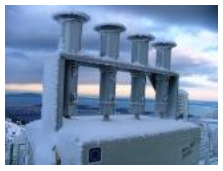 Modern air quality monitoring largely relies on automatic analyzers which provide continuous real-time information of pollutant concentrations in ambient air. Today in Croatia there are 36 such automatic monitoring stations located in the largest cities and major industrial areas. Majority of these belong to local air quality networks. State air quality network has now 11 automatic monitoring sites in urban areas and it will be completed with 12 new rural stations as part of the EU-funded PHARE 2006 project "Establishment of Air Quality Monitoring and Management System". As a result, Croatia will have an extensive net of 48 automatic monitoring stations throughout the country for the assessment of air quality with an overall purpose to protect human health and ecosystems from impacts of air pollution.
Modern air quality monitoring largely relies on automatic analyzers which provide continuous real-time information of pollutant concentrations in ambient air. Today in Croatia there are 36 such automatic monitoring stations located in the largest cities and major industrial areas. Majority of these belong to local air quality networks. State air quality network has now 11 automatic monitoring sites in urban areas and it will be completed with 12 new rural stations as part of the EU-funded PHARE 2006 project "Establishment of Air Quality Monitoring and Management System". As a result, Croatia will have an extensive net of 48 automatic monitoring stations throughout the country for the assessment of air quality with an overall purpose to protect human health and ecosystems from impacts of air pollution.
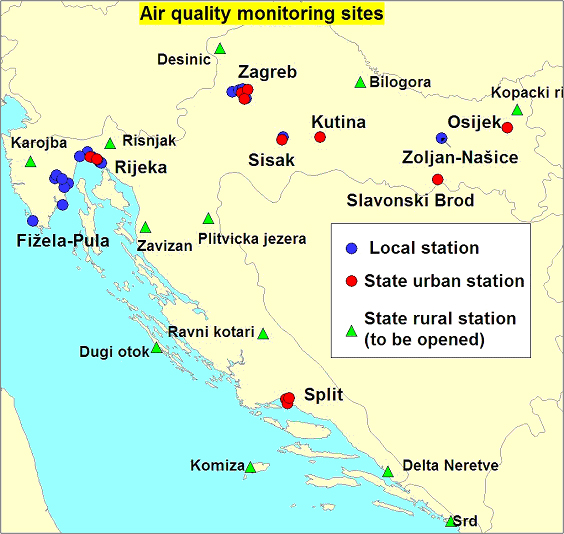
Ministry of Environmental Protection, Physical Planning and Construction (MEPPPC) coordinates air quality monitoring and air pollution prevention activities on national level and also provides access to the real-time concentrations of the state network http://zrak.mzopu.hr/. Regional and local authorities are responsible for pollution prevention activities and measurements on the local level.
The completed State Network will be managed by the Meteorological and Hydrological Service of Croatia (MHSC) which also maintains the calibration laboratory for the control of instrument performance, as well as the upgraded chemical laboratory for detailed analyses of atmospheric pollutants.
Croatian Environment Agency (CEA) collects all air quality monitoring data to the National Environment Information System and also provides access to the real-time concentrations of local networks on the Internet http://lokalnemreze.azo.hr/iszo/iskzl/.
High concentrations of air pollutants pose a threat to human health. The most vulnerable are children, elderly and people with asthma or other lung and heart problems. EU has adopted pan-European air quality standards (limit values) to reduce the risks for human health and ecosystems.
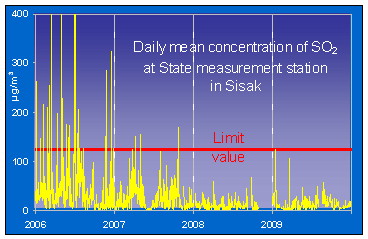 Since the early 1990s, pollutant emissions from large point sources have generally decreased, due to increased use of low-sulphur fuels as an energy source and extension of district heating, decline in industrial production, and the shutdown or replacement of polluting industry with a new environmentally cleaner technology. In Sisak, the SO2 concentrations have decreased substantially (see the graph), but in some heavily industrialized regions the episodic high concentrations of SO2 still occur.
Since the early 1990s, pollutant emissions from large point sources have generally decreased, due to increased use of low-sulphur fuels as an energy source and extension of district heating, decline in industrial production, and the shutdown or replacement of polluting industry with a new environmentally cleaner technology. In Sisak, the SO2 concentrations have decreased substantially (see the graph), but in some heavily industrialized regions the episodic high concentrations of SO2 still occur.
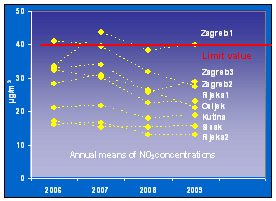 In the future, pollution prevention measures will have to focus more and more on the road transport sector.
Growth in the living standards and mobility have resulted in the increased number of vehicles and kilometres covered. This has compensated the positive development achieved by the adoption of less polluting vehicle technology such as catalytic converters.
In the future, pollution prevention measures will have to focus more and more on the road transport sector.
Growth in the living standards and mobility have resulted in the increased number of vehicles and kilometres covered. This has compensated the positive development achieved by the adoption of less polluting vehicle technology such as catalytic converters.
The emissions from road traffic include nitrogen dioxide (NO2), carbon monoxide (CO), benzene, and particulate matter (PM10), and these emissions contribute to formation of smog and ozone (O3). Vehicle exhausts are especially harmful to human health as undiluted emissions occur directly at the human breathing height.
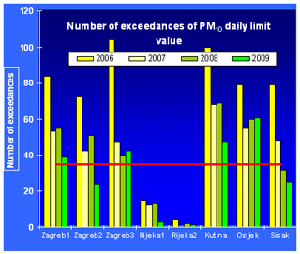 High concentrations of particulate matter, PM10, are very common. The concentrations are highest during mid-winter, December and January, and have daily peaks at early morning and evening. High concentrations of PM10 occur both in biggest cities as well as in smaller towns. Possible sources are traffic, residential heating and industry. The most harmful to human health is the smallest fraction of particulate matter (particles with aerodynamic diameter less than 2.5 micrometer - PM2.5). Monitoring of these hazardous fine particles is only starting in Croatia.
High concentrations of particulate matter, PM10, are very common. The concentrations are highest during mid-winter, December and January, and have daily peaks at early morning and evening. High concentrations of PM10 occur both in biggest cities as well as in smaller towns. Possible sources are traffic, residential heating and industry. The most harmful to human health is the smallest fraction of particulate matter (particles with aerodynamic diameter less than 2.5 micrometer - PM2.5). Monitoring of these hazardous fine particles is only starting in Croatia.

